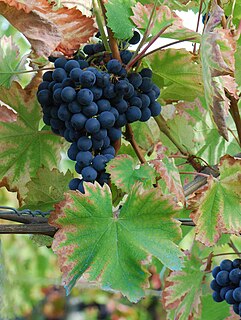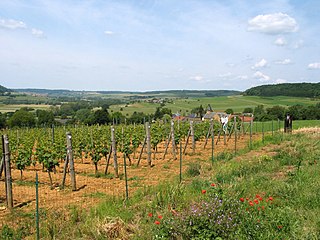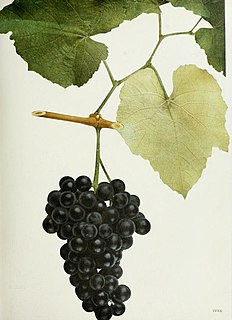
Syrah, also known as Shiraz, is a dark-skinned grape variety grown throughout the world and used primarily to produce red wine. In 1999, Syrah was found to be the offspring of two obscure grapes from southeastern France, Dureza and Mondeuse Blanche. Syrah should not be confused with Petite Sirah, a cross of Syrah with Peloursin dating from 1880.

Durif is a variety of red wine grape primarily grown in Australia, California, France, and Israel. Since the end of the 20th century, wineries located in Washington's Yakima River Valley, Maryland, Arizona, Texas, West Virginia, Chile, Mexico's Baja California Peninsula, and Ontario's Niagara Peninsula have also produced wines from Durif grapes. It is the main grape known in the U.S. and Israel as Petite Sirah, with over 90% of the California plantings labeled "Petite Sirah" being Durif grapes; the U.S. Bureau of Alcohol, Tobacco, Firearms and Explosives (ATF) recognizes "Durif" and "Petite Sirah" as synonyms for the same grape. It produces tannic wines with a spicy, plummy flavour. The grape originated as a cross of Syrah pollen germinating a Peloursin plant. On some occasions, Peloursin and Syrah vines may be called Petite Sirah, usually because the varieties are extremely difficult to distinguish in old age.

Sangiovese is a red Italian wine grape variety that derives its name from the Latin sanguis Jovis, "the blood of Jupiter". Though it is the grape of most of central Italy from Romagna down to Lazio, Campania and Sicily, outside Italy it is most famous as the only component of Brunello di Montalcino and Rosso di Montalcino and the main component of the blends Chianti, Carmignano, Vino Nobile di Montepulciano and Morellino di Scansano, although it can also be used to make varietal wines such as Sangiovese di Romagna and the modern "Super Tuscan" wines like Tignanello.

Baco blanc or Baco 22A is a French-American hybrid grape variety. It is a cross of Folle blanche and the Noah grape, created in 1898 by the grape breeder François Baco. Folle blanche is its Vitis vinifera parent. Noah, its other parent, is itself a cross of Vitis labrusca and Vitis riparia.

Mourvèdre is a red wine grape variety grown in many regions around the world including the Rhône and Provence regions of France, the Valencia and Jumilla denominaciones de origen of Spain, as well as the Balearic Islands, California and Washington and the Australian regions of South Australia and New South Wales, as well as South Africa. In addition to making red varietal wines, Mourvèdre is a prominent component in "GSM" blends. The variety is also used to make rosé and port-style fortified wines.

Vitis labrusca, the fox grape, is a species of grapevines belonging to the Vitis genus in the flowering plant family Vitaceae. The vines are native to eastern North America and are the source of many grape cultivars, including Catawba, Concord, Delaware, Isabella, Niagara, and many hybrid grape varieties such as Agawam, Alexander and Onaka. Among the characteristics of this vine species in contrast to the European wine grape Vitis vinifera are its "slip-skin" that allows the skin of the grape berries to easily slip off when squeezed, instead of crushing the pulp, and the presence of tendrils on every node of the cane. Another contrast with European vinifera is the characteristic "foxy" musk of V. labrusca, best known to most people through the Concord grape. This musk is not related to the mammalian fox, but rather to the strong, earthy aromas characteristic of the grapes that were known by early European-American settlers in the New World. The term "foxy" became a sort of catchall for the wine tasting descriptors used for these American wines that were distinct from the familiar flavors of the European viniferous wines.

Tannat is a red wine grape, historically grown in South West France in the Madiran AOC, and is now one of the most prominent grapes in Uruguay, where it is considered the "national grape".
Plantet is a red wine grape variety that was one of the hybrid grape created by French physician and grape breeder Albert Seibel. While the exact parentage of the grape is unknown, the most popular theories has it as a cross of two Seibel grapes, Seibel 867 x Seibel 2524 with another theory speculating that Plantet's parentage was Seibel 4461 crossed with Berlandieri-Jacquez.

Fer is a red French wine grape variety that is grown primarily in South West France and is most notable for its role in the Appellation d'Origine Contrôlée (AOC) wines of Gaillac, Marcillac and Béarn but can also be found as minor component in the wines of Madiran, Cabardès and Bergerac. The grape is also featured in red blends from several vin de pays regions in the south west with significant plantings coming from the Aveyron department.

Aramon or Aramon noir is a variety of red wine grape grown primarily in Languedoc-Roussillon in southern France. Between the late 19th century and the 1960s, it was France's most grown grape variety, but plantings of Aramon have been in continuous decline since the mid-20th century. Aramon has also been grown in Algeria, Argentina and Chile but nowhere else did it ever reach the popularity it used to have in the south of France.
Villard grapes are French wine hybrid grape created by French horticulturist Bertille Seyve and his father-in-law Victor Villard. They include the dark skin Villard noir and the white-wine variety Villard blanc with both being members of the Seyve-Villard grape family. Villard noir is a cross of two other French hybrids, Siebel 6905 and Seibel 7053 created by physician and plant breeder Albert Seibel. Like Villard noir, Villard blanc was produced as a crossing of two Seibel grapes, in this case, Le Subereux and Seibel 6468.
Couderc noir is a red wine hybrid grape that was formerly grown primarily in the South West France wine region and around the Gard département in the Languedoc-Roussillon region. The vine produces high yields and ripens late, creating a wine that is deeply colored with a distinct, earthy flavor. Couderc noir is normally used for mass commercial and table wines.

Nielluccio is a red wine grape variety that is widely planted on Corsica. It is the principal grape variety used in the production of the Appellation d'Origine Contrôlée AOC red wine Patrimonio, where it must by law make up 95% of the blend. An early budding vine, Nielluccio produces wines lacking in color and with high alcohol levels. It is commonly used to make rosé wine.

Pais is a red wine grape that has played a prominent role in the Chilean wine industry. Up until the turn of the 21st century, it was Chile's most planted variety until it was overtaken by Cabernet Sauvignon. Today it is most commonly used in the production of jug wine in the Bío-Bío, Maule and Itata River regions in the south. The grape is sometimes known as Negra Peruana. In Argentina the grape is known as Criolla Chica.

Galician wine is Spanish wine made in the autonomous community of Galicia in the northwest corner of Spain. It includes wine made in the provinces of A Coruña, Ourense, Pontevedra and Lugo. Within Galicia are five Denominacións de Orixe (DO): Monterrei, Rías Baixas, Ribeira Sacra, Ribeiro and Valdeorras. In recent years, the region has seen a resurgence in its wine industry led by the international acclaim being received by the Rías Baixas region for its Albariño wines.
Ribolla Gialla is a white wine grape grown most prominently in the Friuli region of northeast Italy. The grape is also found in Slovenia where it is known as Rebula. In Friuli, the grape thrives in the region around Rosazzo and Gorizia. In Slovenia, the grape is grown prominently in the Brda region. The grape is not related to the Friuli red wine grape Schioppettino, which is also known as Ribolla Nera. The obscure, lower quality Ribola Verde grape is a mutated version that is not widely used.

Belgian wine is produced in several parts of Belgium and production, although still modest at 1,400 hectoliters in 2004, has expanded in recent decades.
Royalty is a rouge Californian wine grape variety that was developed in 1938 by Dr. Harold P. Olmo of the University of California, Davis. The grape is a red fleshed teinturier which, unlike most red wine grapes, will produced red-tinged colored wine even without maceration time on the skins. The grape is a hybrid being produced from the Vitis vinifera Trousseau gris variety from the Jura wine region of France and the teinturier grape Alicante Ganzin that, itself, is a hybrid of a Vitis rupestris variety and the Vitis vinifera grape Aramon.

Ives noir is a red hybrid grape variety that is grown throughout the United States. Named after its propagator, Connecticut wine grower Henry Ives, the grape's pedigree and exact origin are unclear. After Prohibition in the United States, Ives was a popular grape used in the production of sweet port-style wines but saw its plantings steadily decrease throughout the 20th century as the vine's susceptibility to air pollution took its toll.

Douce noir is a red Savoyard wine grape variety that has historically been grown in the Savoy region, but today is more widely planted in Argentina. The earliest mention of the grape dates from when Etruscans first planted Bonarda some 3.000 years ago in the Padana Region. It arrived in Savoie in the early 19th century, and by the end of the century it was the most widely grown red wine grape in the region. In the early 21st century it was discovered that the Bonarda grape, which is the 2nd most widely planted red grape, after Malbec, in Argentina was the Italian wine grape Bonarda Piemontese imported by Italian immigrants. The grape is also grown in California where it is known as Charbono.















